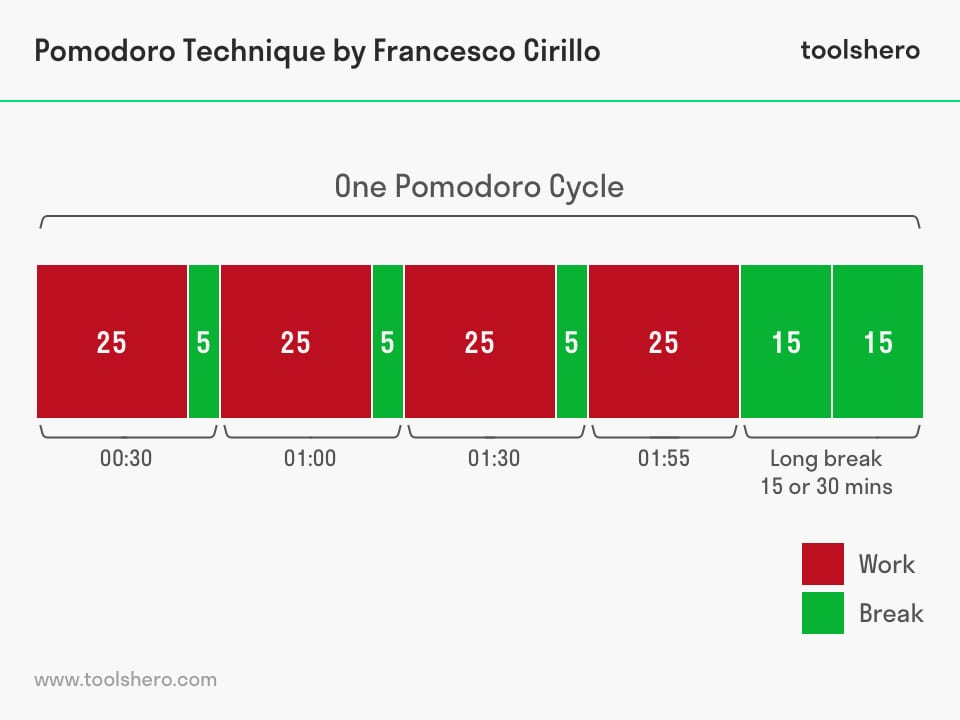Pomodoro Technique explained

Pomodoro Technique: this article describes the Pomodoro Technique by Francesco Cirillo in a practical way. This article also contains the general definition of the Pomodoro Technique, its characteristics and more. After reading you will understand the basics of this time management system and effectiveness tool. Enjoy reading!
What is the Pomodoro Technique?
The Pomodoro Technique was developed in the late 1980s, by the Italian, Francesco Cirillo as a time management system technique. One main characteristic of this now classic technique is the use of a tomato shaped cooking alarm, used to mark periods of 25 minutes in which to concentrate.
Pomodoro technique timer
The Pomodoro technique timer was given the Italian name ‘Pomodoro’ (Italian word for tomato) due to the kitchen alarm that Cirillo had at the time. Which was in the shape of a red tomato. Cirillo called every 25-minute time period a ‘Pomodoro’.
Today, the Pomodoro Technique is a registered trademark and you can follow certified Pomodoro Technique training courses that focus on effective divisions of time. The technique is used by many university students as a time management method to schedule work time for important tasks. Scheduling a pomodoro session enables them to start working with great focus on their educational tasks.
Background of the Pomodoro technique
It was Cirillo himself who noticed that he could not work for long periods of time. He would get distracted by people around him, or he would constantly divert and delay himself.
So he picked up a cooking alarm from the kitchen and forced himself to work on a single task for 25 minutes. The famous Pomodoro technique timer was in shape of a tomato.
After the 25 minutes, he would allow himself to take a short break of a few minutes. In addition, he also made it clear that he could not be disturbed during those 25 minutes. When this turned out to work well, he set to work developing this method.
Pomodoro Technique benefits
The Pomodoro technique has a number of advantages. Apart from learning how to deal with both internal and external distractions, the tendency to postpone work is also prevented.
Because you focus on the task which needs to be completed within 25 minutes, you are able to work much faster and distractions are minimised. This results in better work satisfaction and means that the work can be more structured.
In addition, complex tasks can be divided into smaller subdivisions, which gives you a better overview and more motivation to start the larger job.
This is motivating and energising. Finally, you get a better insight into the number of tasks and the time that each task will take.
5 Steps
The Pomodoro Technique consists of five steps, which means it is important to follow these steps carefully and seriously and only take the designated breaks.
Step 1 – Determine the tasks
Knowing which tasks should be done in advance gives a helpful overview. By writing all the activities out on paper, people know exactly what needs to be done. None of the activities should be worried about in your head, they should all be out on paper.
Step 2 – Determine the order
It is now time to make an inventory of all the tasks from the list and to make sure that each activity takes no more or less than exactly 25 minutes.
Then the tasks, called Pomodoros, should be placed in order of priority. This means that tasks that have the highest priority come first and must therefore be carried out first.
Step 3 – Getting Started
Now it’s time to really get started. The moment of setting the Pomodoro Timer means the first task will be performed. When using a smartphone or tomato shaped timer, it is good to make sure that there is no incidental chances to look at the phone and all the attractive distractions therein.
An irritating ticking cooking alarm may also be distracting. It needs to be a proper timer or stopwatch. By respecting the Pomodoro Technique, you are able to stay focused on the task.
Step 4 – Short break
Here comes the moment for a small reward; the 25 minutes are over and the pomodoro rings, the task is done. This means that the task can be crossed off the list and a short minute break of 3 to 6 minutes can be taken.
That’s exactly enough time to satisfy the need for a break and to prepare you mentally for the next task. Continue in the same way until four Pomodoros are completed. Including the short breaks this means almost two hours of work.
Step 5 – Long break
After finishing four Pomodoros, the time has come for a longer break of 15 to 30 minutes. That’s just enough time to refuel, chat with a colleague, take a short walk or have something to eat.

Figure 1 – Pomodoro Technique Example
Then start the next block of two hours, starting again at step 3. At the end of the working day, it is a good idea to have a task list (steps 1 and 2) ready for the next day, so that you can start the tasks immediately and purposefully.
Pomodoro Technique: the golden rules, based on study
Typically, the Pomodoro Technique works very well and study shows that people are (almost) always able to keep focused on the work session for 25 minutes. Nevertheless, people are quite quickly distracted.
To minimise these, there are three golden Pomodoro rules that can be used to settle all internal and external distractions:
Rule 1 – internal interruptions: process, register and focus
It is not bad to acknowledge distracting thoughts. By writing them down at the bottom of the task list, there is a clear overview of the exact nature of the internal distractions.
How often is someone tempted to open Facebook, check WhatsApp or read the digital news? The goal is to get the focus back. By logging each of the internal distractions within a Pomodoro, this makes them literally visible and it is possible to begin to reduce these internal interruptions.
Rule 2 – external interruptions: inform, negotiate, action
These interruptions are mostly from colleagues, clients, and visitors who can distract with questions, phone calls or emails. Therefore, it is good idea to inform them in advance that you will not be available for a certain amount of time.
Also, a closed door or reserved workplace can provide a clear signal, making everyone aware that there will be no time or attention for them. Secondly, it’s a good idea to negotiate with colleagues, clients or visitors and look for another suitable moment to talk with them. Thirdly, action must be taken. A promise is a promise, so if an agreement has been made it also needs to be met.
Rule 3 – a Pomodoro is not divisible
Of course, a real tomato can be cut into pieces. But a task, that now has the name Pomodoro, can not be divided into pieces; 25 minutes are really 25 minutes. No more and no less.
Finally, the timer indicates that the time is over. So do not continue after 25 minutes, because that can also be demotivating.
If a task is shorter than 25 minutes, it can be good to combine it with another task. If a task takes longer than 25 minutes, it is good to divide this task into several Pomodoros in advance.
Pomodoro Technique and assertiveness
The Pomodoro Technique is purely about maintaining concentration and the effective organisation of your own work. It also involves a degree of assertiveness; say no to your surroundings and stand up for your own tasks.
If there seems to be too many tasks on someone’s plate time after time, the Pomodoro Technique helps to give an insight into what he/she has been doing all day.
Not only for that person, but also for the surrounding environment and manager. Perhaps the observation will be made that the work can not be done by one person, and that the workload can only be decreased by taking additional staff.
It’s Your Turn
What do you think? Is the Pomodoro Technique applicable in your daily work? Do you recognize the practical explanation or do you have more suggestions? What are your success factors for working long periods of time without getting distracted or disturbed? Are you using a Pomodoro Timer?
Share your experience and knowledge in the comments box below.
More information
- The Pomodoro Technique® – proudly developed by Francesco Cirillo | Cirillo Consulting GmbH. (n.d.). Retrieved from https://cirillocompany.de/pages/pomodoro-technique
- Cirillo, F. (2006). The pomodoro technique (the pomodoro). Agile Processes in Software Engineering and, 54(2).
- Gobbo, F., & Vaccari, M. (2008, June). The pomodoro technique for sustainable pace in extreme programming teams. In International Conference on Agile Processes and Extreme Programming in Software Engineering (pp. 180-184). Springer Berlin Heidelberg.
How to cite this article:
Mulder, P. (2017). Pomodoro Technique (Cirillo). Retrieved [insert date] from Toolshero: https://www.toolshero.com/personal-development/pomodoro-technique-francesco-cirillo/
Original publication date: 12/18/2017 | Last update: 05/12/2023
Add a link to this page on your website:
<a href=”https://www.toolshero.com/personal-development/pomodoro-technique-francesco-cirillo/”>Toolshero: Pomodoro Technique (Cirillo)</a>












